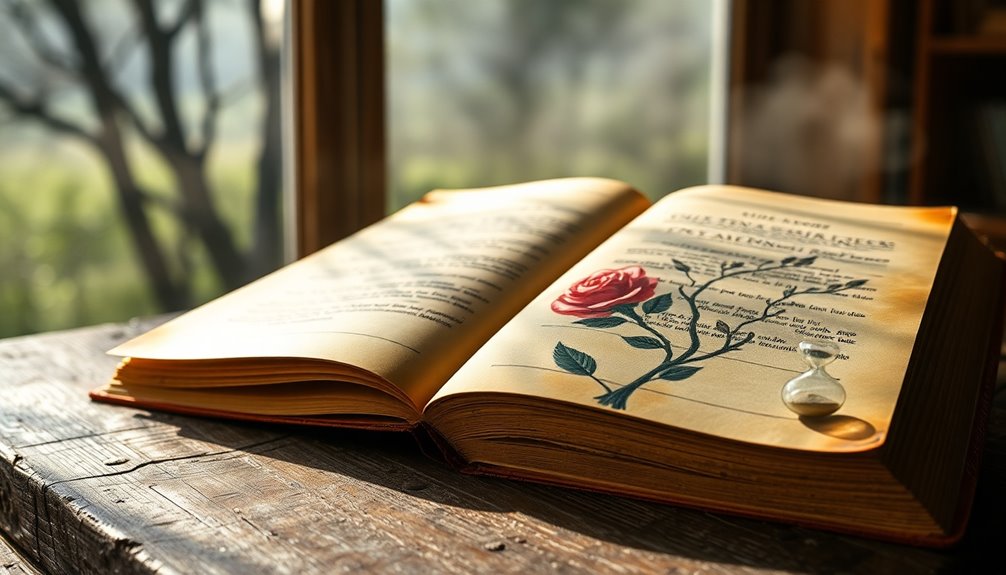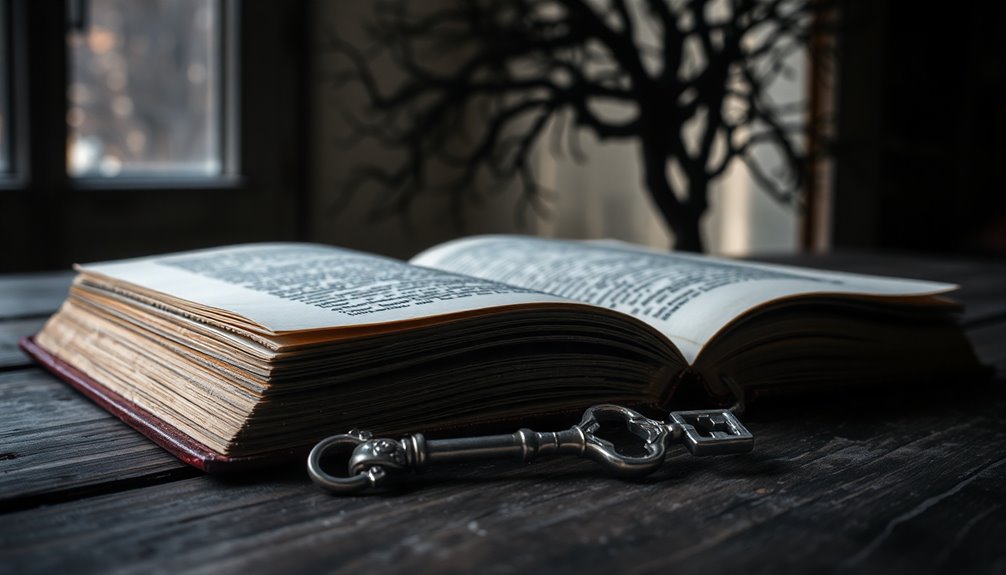Symbolism in literature transforms everyday objects and ideas into exciting messages that make stories richer! You'll find that symbols, like colors or objects, can express important themes and emotions. For example, the green light in *The Great Gatsby* stands for unreachable dreams, while a conch shell in *Lord of the Flies* represents order and civilization. These symbols invite you to think deeper about what the story means. You get to explore complex ideas without feeling overwhelmed. So, as you explore different stories, you'll discover more about how symbols bring them to life in amazing ways!
Key Takeaways
- Symbolism conveys complex ideas and themes through representational imagery, enhancing emotional connections in narratives.
- Metaphors and allegories serve as powerful tools, adding layered meanings throughout the story.
- Colors, objects, and seasons are commonly used symbols that evoke specific emotional responses and signify deeper meanings.
- Repeated symbols can create motifs, developing broader themes and inviting deeper exploration of the text.
- Context is crucial for interpreting symbols, ensuring they are neither too obvious nor overly concealed.
Definition and Purpose of Symbolism

In the domain of literature, symbolism serves as a powerful tool for expressing complex ideas through representational imagery. It's like a secret language where objects or elements represent something much deeper than what you see on the surface. When you read a story, you might notice how certain images, like a rose, can symbolize love or beauty. This literary device helps you connect with the narrative on an emotional level.
Symbolism allows authors to convey deeper meanings and themes that make the story richer. It can enhance the mood, making you feel excited, sad, or even curious. For example, a dark storm might represent conflict or turmoil, while a bright sun could symbolize hope and happiness.
You might also encounter metaphors, which are a type of symbolism that compares two different things, adding layered meanings to the text. Recognizing symbolism isn't just about understanding what something means; it's about digging deeper to discover the emotional depth behind it.
Types of Symbolism

Symbolism in literature comes in various forms, each adding layers of meaning to the text. Understanding the types of symbolism helps you uncover deeper meanings and themes.
Here are some key types to explore:
- Metaphors: These directly compare two unlike things, enriching your understanding of the text.
- Allegories: These are extended metaphors that unfold throughout entire narratives, offering a bigger picture.
- Colors: Different colors, like black for death or white for purity, evoke strong emotional responses.
- Objects: Everyday items can carry powerful symbolism, such as chains representing bondage or ladders symbolizing spiritual growth.
- Seasons: Each season has its own meaning; for example, spring signifies new beginnings, while winter symbolizes endings.
Common Symbols in Literature

Literature is rich with common symbols that enhance the narrative and deepen the reader's experience. Authors often rely on these symbols to convey important themes and emotions. Different symbols can have powerful meanings, and you might be surprised by how often you encounter them!
Here's a quick look at some common symbols in literature:
| Symbol | Symbolic Meaning | Famous Example |
|---|---|---|
| Color Red | Passion, love, or danger | The Scarlet Letter by Hawthorne |
| Color Green | Growth, hope, or envy | The green light in The Great Gatsby |
| Seasons | Change and cycles | Spring for new beginnings, winter for endings |
When you read, pay attention to colors like yellow, which can symbolize happiness or caution. Objects like chains and ladders also play an important role, representing connection or ascension. Seasons add depth too; spring means new beginnings, while fall signifies change.
Examples of Symbolism

Many works of literature use symbolism to convey deeper meanings and themes that resonate with readers. Authors often choose symbols that represent something else, allowing you to explore complex ideas.
Here are some examples of symbolism you might find:
- In The Great Gatsby the green light symbolizes Gatsby's unattainable dreams and hope for the future.
- In The Scarlet Letter the letter "A" worn by Hester Prynne represents sin, guilt, and societal views on morality.
- In Animal Farm the farm itself serves as an allegory for the Russian Revolution, with pigs representing key figures.
- In Lord of the Flies the conch shell symbolizes civilization and order, while its destruction shows the collapse of societal norms.
- In Of Mice and Men Candy's dog symbolizes the fate of those deemed useless in a harsh society.
These examples of symbolism help you see how literary devices can deepen your understanding of characters and themes.
Through creative writing, authors use symbolism as a literary tool to make their stories more impactful. Exploring these symbols can be a fun way to engage with literature!
Analyzing Symbolism in Writing

Writers often use symbolism to add layers of meaning to their narratives, inviting readers to uncover deeper themes and emotions. When you read literature, you might notice symbols that represent big ideas. For example, a rising sun might symbolize hope or a new beginning. By analyzing these symbols, you can discover their true meaning and how they connect to the story.
To analyze symbolism, pay attention to the context in which symbols appear. Sometimes, their meanings change as the narrative unfolds or depending on a character's perspective. Writers want to create a balance; symbols shouldn't be too obvious or too hidden. This balance allows you, the reader, to interpret their meaning without feeling confused.
As you immerse yourself in the text, think about how repeated symbols can form motifs, developing broader themes throughout the story. This encourages deeper engagement and critical thinking.
Frequently Asked Questions
What Is Symbolism and How Is It Used in Literature?
Symbolism is when something stands for something else. In stories, objects, characters, or events can represent big ideas or feelings.
For example, a dove might symbolize peace, while a storm could mean trouble. This helps you connect more deeply with the story!
When you read, look for these symbols. They add layers to the tale, making it richer and more exciting. Understanding them brings you closer to the author's message!
What Effect Does Symbolism Have on the Reader?
Symbolism can really jazz up your reading experience! When you spot a symbol, it's like finding a hidden treasure. It makes you feel more connected to the story and characters.
You'll notice how symbols stir emotions, like hope or longing. Plus, they encourage you to think deeper about the themes and ideas.
Everyone might see symbols a little differently, sparking fun discussions about what they mean. That's what makes reading so exciting!
What Are 5 Examples of Symbols?
Symbols in stories bring deeper meaning to what you read!
For example, in *The Great Gatsby*, the green light shows Gatsby's hopes.
In *The Scarlet Letter*, the letter "A" represents sin and shame.
In *Animal Farm*, Boxer symbolizes the working class's struggles.
The conch shell in *Lord of the Flies* stands for order, while Candy's dog in *Of Mice and Men* highlights loneliness.
These symbols make the stories more exciting and relatable!
What Is the Purpose of Symbolization?
Symbolization's purpose is to add depth and meaning to what you read.
Imagine a simple object, like a heart. It can represent love, friendship, or even sadness!
By using symbols, writers help you connect with their stories on a deeper level. You see, symbols turn ordinary things into powerful ideas, making the story more exciting and relatable.
They bring emotions alive, allowing you to understand characters and themes in a joyful, engaging way.
Conclusion
So, as you plunge into the world of literature, remember that symbols are like hidden treasures waiting to be discovered! They add depth and meaning to stories, making them more exciting. Each symbol can tell a different tale, helping you see things in a new light. Just like a map guiding you through a magical forest, symbolism leads you to deeper understanding. Keep exploring, and you'll find that every story holds secrets just for you!











